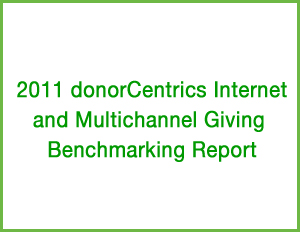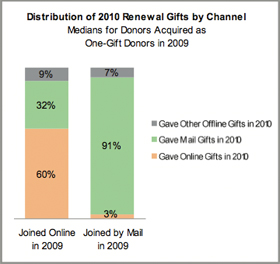2011 donorCentrics Internet and Multichannel Giving Benchmarking Report

Target Analytics, a Blackbaud company, has released the third edition of it’s groundbreaking research into multichannel giving trends among nonprofit organizations. This report continues to be the most significant analysis of online/offline giving trends based on actual data from nonprofits.
The 2011 donorCentrics Internet and Multichannel Giving Benchmarking Report provides analysis of 28 major nonprofit organizations and transactions for over 15 million donors and more than $1 billion in revenue.
The organizations that participate in the Target Analytics online benchmarking group are prominent nonprofits covering a range of sectors, including animal welfare, the environment, health, human services, international relief, and societal benefit.
Key Findings:
The majority of giving still comes from offline channels, but online continues to be a significant source of giving and new donors. Online giving growth was not slowed by the most recent recession. This is in line with the 2010 Online Giving Report.
 The dominate giving channel for new donors 64 years old and younger is online — not offline. Revenue per new donor and household income are significantly higher for online giving compared to offline.
The dominate giving channel for new donors 64 years old and younger is online — not offline. Revenue per new donor and household income are significantly higher for online giving compared to offline.
Retention rates for online donors continue to lag offline donor trends. This is a recurring theme from previous studies. This is offset by larger long-term value trends for online donors, but retention rates are a serious issue that nonprofits need to focus on improving. Only 11% of online donors acquired in 2007 were still giving in 2010.
Online donors continue to switch channels and become offline donors. 32% of online donors became offline donors the following year compared to just 3% of offline donors choosing to now give online. After three or four years, about half of all online-acquired donors are giving offline gifts and over 40% are giving exclusively offline.
Multichannel giving does correspond with higher retention and increased donor value for new donors acquired online. The ability to use another channel drives up the retention and long-term value of a population of newly acquired donors.
Observations:
The participants in the benchmarking group are dominated by direct mail focused nonprofits. That means that organizations with a major giving or annual fund focus are likely to have some performance differences. But analysis of actual data, instead of online or phone surveys, is still much more accurate and meaningful.
Retention rates for both new online and offline donors are bad. They get worse over time. All the new tips, tricks, and use of social media will not fix it. Nonprofit organizations need to focus even more on stewardship, relationship management, and diversification of fundraising sources.
Show me an organization not being multichannel and I bet there are lots of departmental and technology silos getting in the way. And I don’t mean just doing email or direct mail together. I mean seriously developing communication, engagement, stewardship, and retention programs that leverage mail, phone, web, email, social, and mobile. Now that everyone is raising money online the differentiators are going to be how well a nonprofit can leverage each contact point.
